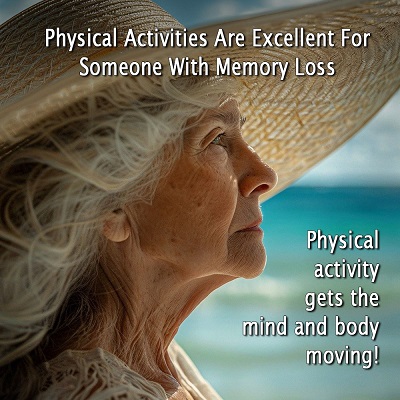 Now many people with memory loss or dementia have to be careful physically, but that doesn’t mean they have to be stationary for the rest of their lives. Moving is too important for that to be allowed to happen! It’s about finding gentle, enjoyable ways to keep the body moving.
Now many people with memory loss or dementia have to be careful physically, but that doesn’t mean they have to be stationary for the rest of their lives. Moving is too important for that to be allowed to happen! It’s about finding gentle, enjoyable ways to keep the body moving.
For someone with memory loss, physical activity can keep the blood flowing to the brain, providing it with fresh oxygen and nutrients that support cognitive health.
Physical activities can also help establish a regular sleep pattern, which is essential for mental clarity.
Staying active also helps with balance, flexibility, and strength, which are all crucial for reducing the risk of falls and helping them feel more secure.
Physical Activities to Improve Their Health and Mood
With these benefits in mind, here are some physical activities you can help them with. They will feel better physically and emotionally.
Walking and Stretching
These two activities are simple yet effective. Walking helps the person see the sun and get some fresh air. You might find that when they are outdoors, away from their inside distractions, they open up more as their observations begin to trigger some memories. Even a 10-15 minute walk each day can make a big difference, as the walk provides both mental and physical stimulation.
As for stretching, you can guide them through simple stretches, such as reaching their arms up, stretching side to side, or gently rolling their shoulders. Stretching helps maintain their flexibility, keeps their muscles from becoming tight, and can even reduce stiffness in their joints.
Consider turning stretching into a morning or evening routine, or before their daily walk. This activity is a soothing way to begin or end the day, helping to relax their mind while gently activating their body. You might even like to put on some calming music and use some essential oils, so that it feels less like exercise and more like a self-care treatment.
Dancing In The Lounge Room
Who doesn’t like to get up and dance while no one is watching? Listening to music and moving those hips is a great way to exercise! They don’t even have to get out of their seat if they can’t or don’t want to. They can just tap their feet and clap their hands to the beat of the music. It will still get their blood and oxygen pumping.
Music has a special way of triggering memories too, so dancing and singing can provide a mood boost and a gentle cardio workout at the same time.
Chair Exercises for Physical Activity
If moving around is more challenging, chair exercises provide a comfortable way to stay active. With seated exercises, they can stretch, lift light weights – which can be a book or a water bottle, or practice simple movements like lifting their legs or raising their arms.
Have you seen all the ads for seated yoga activities lately? That’s because anyone can do them and they’re easy to do yet so beneficial.
Ball Activities
Throwing a ball can be a wonderful physical activity for someone with memory loss! It’s a great way to stay active while improving coordination and motor skills. The ball can be a big blow-up ball if the idea of throwing a firm ball is daunting. The distance can be short or long too. There are no rules!
Throwing a ball back and forth not only provides gentle physical exercise, but it can help improve hand-eye coordination, and cognitive function.
Whether they’re reaching to catch the ball, tossing it back, or just moving to retrieve it, the person will benefit from all the movement. This is important for maintaining joint flexibility, mobility, and balance.
As for boosting their cognitive function, the act of catching or aiming a throw requires focus and attention, which can provide cognitive stimulation. It’s a great way to engage their brain without feeling like it’s a task. Plus, they may remember different ball games they have played and want to play out some of the things they remember from their past experiences.
One more thing, you can play ball inside too! Make it a soft one, so nothing gets broken, and let the person sit in a chair if necessary. They will still be moving and having fun.
As you can see, physical activities don’t have to be too physical, intense or demanding to make a positive impact. They can be simple movements like a leisurely stroll, or throwing a ball. Regardless of what physical activity they do, it’s important for everyone to get moving every day, including those dealing with memory loss issues.
By helping them stay active in these gentle, enjoyable ways, you’re giving them more than just a workout. You’re helping them emotionally too.






